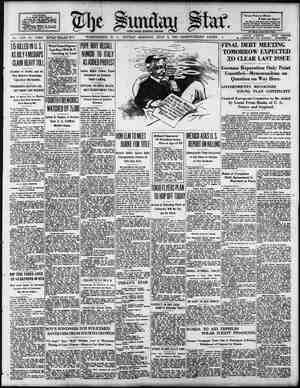Evening Star Newspaper, July 5, 1931, Page 53
You have reached the hourly page view limit. Unlock higher limit to our entire archive!
Subscribers enjoy higher page view limit, downloads, and exclusive features.
PART 7. T was the Spaniards who introduced horse to America and began the greal riding tradition the world has ever —the riding tradition of the West. appearance on horseback and not fair complexions awed the savages. Plains Indians learned to ride, too; their_ of living was completely revolutionized, they entered what is known to history as period of horse culture. For centuries the only yesterday as time runs—the man on horse- was {o remain the symbol of power and + pride. Mag asine WASHINGTON, ‘D, C, JULY 5, I931. THE SAGA OF THE SADDLE But nowhere, whether among savages, among the savage-riding scions ‘of civilization, or down some avenue paraded by generals and overlooked by equestrian statues representing all the culture of antiquity, was the symbol ever :;:pruenhflveo!tbe!ufnotmenmtm “A man on foot is no man at all,” ran & proverb of -the range. A unhorsed was sin ples—“without feet.” he e - who beat out the Santa Fe Trall, outlaws, as well as sheriffs and rangers, the cowboys who owned the world, the cavalrymen who aided the frontiersmen in penning the native centaurs— “Men rush out from the bar and lift the rider from his saddle. And Felix Xavier Aubrey has won the rase.” 20 PAGES., The Stor;}/ of the Man on Horseback, W hose Feats in Both Fact and Legend Have Formed the BV orld’s Greatest Riding Traditions, Is the Story of the Making of America’s West— Excit- ing Days Before the Railroads Pushed Toward the Pacifc. By J. Frank Dobie, y Author of “Coronado’s Children” and several special articles for The Star’s Sunday Magazine. all these lived in the saddle. During the Civil War & band of mounted Texans actually charged a Federal gunboat on Red River! GREAT tradition of Western rides and riders was inevitable. A few of the tales got half told in print, but most of them have remained a part of that ewal heritage which not even the combined power of electricity, gas oline and stcam has yet silenced. In the tales of veterans with bowlegs and a habit of squat- ting while they talk, this saga of the saddle may happily stiil be heard; and over a vast ter- ritory, too rocky and arid ever to be plowed under, it is rehearsed in the earthly speech of . younger men, who as earners of their bacon and Summer’s holiday. The major figures rode with & strenuousness, an endurance, a gesture that only an epic could compass. Always in any class of men one stands out caravans, pulled by long-horned oxen and driven by roaring bullwhackers, were setting out over the Santa Fe Trail. He joined one of the out- fits.” In a short time he was an independent trader, living at Santa Fe and making frequent trips across the plains. The year of his great rides—for he made three—was 1848. It generally took horsemen from three to four weeks to ride the 800 miles between Santa Fe and Independence; the schedule of the military mail was about 30 days; ox wagons required from two to three months. Early in the cold month of January Aubry ar- rived in Independence after having been on the road only 12 days. “The Daily Missouri Repub- lican” (published at St. Louis) declared such & - rate of travel “unprecedented in prairie life.” F5EEpil As a matter of fact, it was not “unprecedent- ed,” and shortly afterward Aubry made the trip in about eight days. When, following it, he got back to Santa Fe in the late Summer, he heard Kit Carson and Maxwell and others buzzing over his record ride. “I can do better,” quietly said. In those days as now money Aubry offered to bet $1,000 that he d make the ride within six days. The money covered. Aubry at once sent two or three §E’
